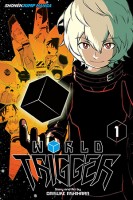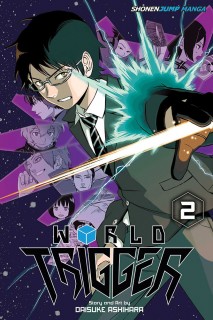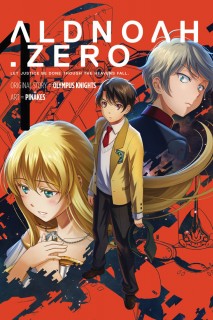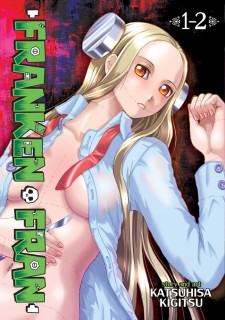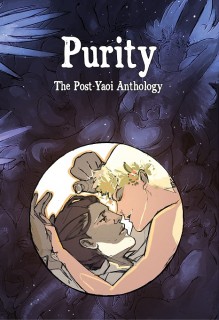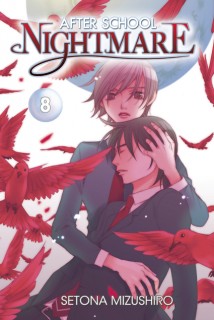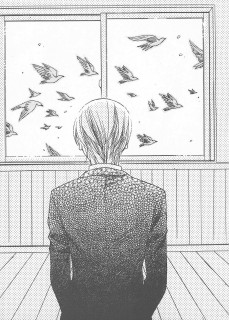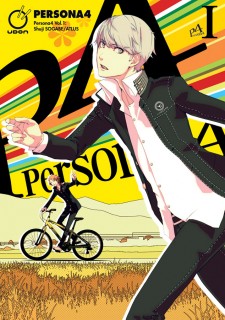 Creator: Shuji Sogabe
Creator: Shuji Sogabe
U.S. publisher: Udon Entertainment
ISBN: 9781927925577
Released: February 2016
Original release: 2009
Shin Megami Tensei is a sprawling multi-media franchise that began as a series of video games in 1987 and has grown to include manga, anime, novels, merchandise, and more. One of the most popular series within Shin Megami Tensei is Persona, which has its own multitude of spin-offs and adaptations. Persona 4 was initially developed as a role-playing game for the PlayStation 2, but the story and characters have inspired multiple other games, novels, anime, and manga series. The first Persona 4 manga was created by Shuji Sogabe, who was also responsible for the earlier Persona 3 manga adaptation. Sogabe’s Persona 4 manga, currently ongoing, has been licensed in English by Udon Entertainment. After a slight delay, the first volume of the series, originally published in Japan in 2009, was released in early 2016. My personal experience with Shin Megami Tensei as a whole is somewhat limited and up until now my knowledge of Persona 4 had largely been earned vicariously through others.
Soji Seta has grown used to transferring from one school to another due to the demands of his parents’ careers, but when they are both sent overseas, Soji is sent to stay with his uncle and young cousin in the small rural town of Inaba. Because Soji has moved so often he doesn’t have many friends and tends to keep his distance from other people. And as a city boy he’s also a bit out-of-place in the countryside. Even so, he’s warmly welcomed by his classmates and is quickly included in their social circles. Only there’s something unsettling about Inaba and Soji finds himself suffering from disorientation and strange dreams. Soon after his arrival, a string of bizarre deaths begin to occur which somehow seem to be connected to a local urban legend. It is said that on rainy nights, staring into the reflection of a television screen will reveal the face of one’s true love. But the truth behind the rumor is even more peculiar. Suddenly, Soji and the others find themselves pulled into another world as they pursue the mysteries surrounding the murders.
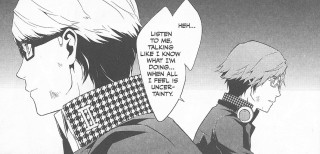 Soji would arguably be the main protagonist of the Persona 4 manga (he’s the player character in the original video game, among other things), but except for the initial chapter most of the first volume is actually told from the perspective of Yosuke Hanamura. Like Soji, Yosuke is a transfer student, having moved to Inaba from a large city six months earlier due to his parents’ work. Although his character is more complex than is initially implied, Yosuke tends to be an easygoing and somewhat clumsy goofball. This provides an interesting contrast to Soji’s colder, more reserved personality. Over the course of the first volume they begin to form a close friendship which will likely become one of Soji’s most important relationships. The connection will also be meaningful for Yosuke whose outwardly upbeat attitude hides feelings of discontent, inadequacy, and doubt. I’m looking forward to seeing how their bond evolves as it seems to be something that they both need.
Soji would arguably be the main protagonist of the Persona 4 manga (he’s the player character in the original video game, among other things), but except for the initial chapter most of the first volume is actually told from the perspective of Yosuke Hanamura. Like Soji, Yosuke is a transfer student, having moved to Inaba from a large city six months earlier due to his parents’ work. Although his character is more complex than is initially implied, Yosuke tends to be an easygoing and somewhat clumsy goofball. This provides an interesting contrast to Soji’s colder, more reserved personality. Over the course of the first volume they begin to form a close friendship which will likely become one of Soji’s most important relationships. The connection will also be meaningful for Yosuke whose outwardly upbeat attitude hides feelings of discontent, inadequacy, and doubt. I’m looking forward to seeing how their bond evolves as it seems to be something that they both need.
Not having yet played any of the Persona 4 video games, I’m not in a position to comment on Sogabe’s manga as a derivative work, but at this point it does appear to be an adaptation that can largely stand on its own. Some elements of gameplay can still be detected, though for the most part they have been convincingly incorporated into the story itself. In addition to the plot and characters, I find the manga’s settings to be particularly intriguing. Sogabe’s stylish artwork and use of shadows and fog create an effectively disconcerting environment in both Inaba and the TV world. But one of the most fascinating and potential-laden aspects of Persona 4 is that while in that alternate reality, fragments of a person’s psyche can physically manifest to either great benefit or great harm. Persona 4, Volume 1 is the introduction to the series so there is a fair amount of setup, but the sense of mystery and danger has already been well-established. So far, I am intrigued by the Persona 4 manga and am curious to see how it continues to develop.

